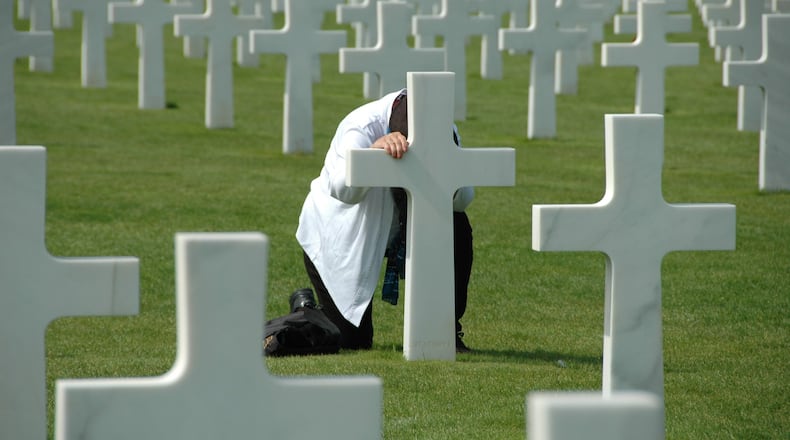The Atlanta Journal carried this hopeful headline on its front page 75 years ago, “D-Day Dawn Finds Atlantians in Prayer.”
Doris Lockerman, who would later become a columnist and the first female associate editor of The Atlanta Constitution, delivered the story, writing that church bells were tolling across the city and uniting residents into “one huge congregation of supplicants.”
“Church members and non-church members, men and women and children of all beliefs and denominations,” she reported, “knelt to pray for the success of the invasion and for the safety of thousands of sons, husbands and brothers locked in the titanic struggle of D-Day.”
About 320,000 Georgians served in the U.S. military during World War II. Among them were more than 5,100 Georgia National Guardsmen who were brought into federal service and put on active duty in September of 1940 before the United States entered the war. Nearly 60 Georgia Guardsmen were killed in the Normandy campaign in France.
“The Georgia National Guard soldiers who gave their lives for freedom during the Normandy campaign demonstrate the commitment of the citizen soldier,” said Maj. Gen. Thomas Carden Jr., Georgia’s adjutant general.
“I often remind people that the National Guard is not composed of ‘weekend warriors.’ Our warriors fight and in many cases sacrifice all of their tomorrows for our today. We can never forget what these brave Georgians and their families have done for our nation.”
Here are four Georgia Guardsmen who made the ultimate sacrifice on D-Day:
Pvt. Albert Cobb joined the Savannah-based Battery F of the 118th Field Artillery Regiment in September of 1940. He was assigned to the 502nd Parachute Infantry Regiment of the 101st Airborne Division. Cobb was killed while parachuting into Normandy and is buried in the Normandy American Cemetery.
A 1938 graduate of Griffin High School, 1st Lt. Thomas Royce Dallas enlisted in the Griffin-based Spalding Grays, Headquarters Company, 30th Infantry Division in 1939, when he was 19. Dallas was selected for officer candidate school and was commissioned a second lieutenant in 1942.
He was assigned as a platoon leader in Company C, 116th Infantry Regiment, 29th Infantry Division. And he was killed in the initial phase of the D-Day landings. He is buried in Oak Hill Cemetery in Griffin.
Pvt. James D. Hogue joined the Macon-based Headquarters Company, 121st Infantry Regiment in August of 1940, when he was 19. Like Cobb, he served with the 502nd Parachute Infantry Regiment. Hogue was killed in action in Normandy.
Technician Fifth Grade Carl G. Kleinsteuber enlisted in Battery D, 118th Field Artillery in 1941, when he was 19. After arriving at Fort Jackson, South Carolina, Kleinsteuber was assigned to the 505th Parachute Infantry Regiment, 82nd Airborne Division.
He was killed in action in Normandy and is buried in the Normandy American Cemetery.
READ MORE
> The Replacement Soldier: The WWII story of Georgia veteran Eddie Sessions
About the Author
Keep Reading
The Latest
Featured








